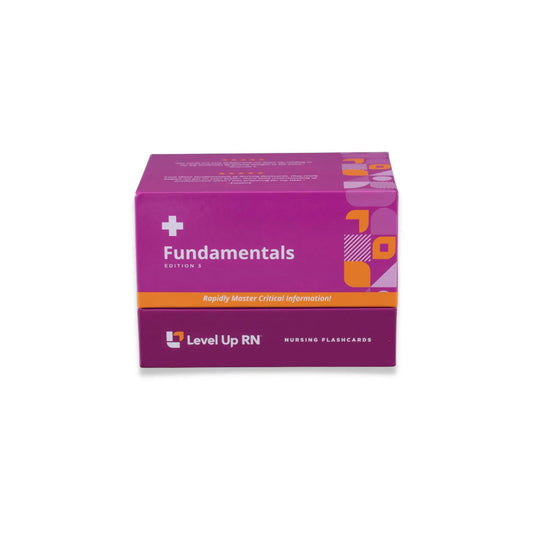Fundamentals - Gerontology, part 11: Polypharmacy and Beer's List
Updated: Ellis ParkerPolypharmacy, including risk factors, prevention, patient teaching, and a selection of medication categories and classes that are included on the Beer's List.
Full Transcript: Fundamentals - Gerontology, part 11: Polypharmacy and Beer's List
Full Transcript: Fundamentals - Gerontology, part 11: Polypharmacy and Beer's List
Hi, I'm Ellis. And in this video, I'll be discussing polypharmacy and the Beers List Criteria. So these cards can be found in the gerontology section of our fundamentals flashcard deck. So if you have that deck, grab these cards, and you can follow along with me. Polypharmacy is defined as using five or more medications concurrently. And the problem with that is that when you are experiencing polypharmacy, you're at a higher risk for falling, for disability, right, for drug-drug interactions, and mortality. So the risk factors for polypharmacy are patients that use multiple over-the-counter medications, patients that have chronic conditions or multiple chronic conditions, right, because they might be taking medicines for each of those, and they're at a higher risk during transitions of care. So periods in their life when they're moving from one facility to another or being discharged into the care of another practice or another facility.
To help prevent polypharmacy, we use the Beers Criteria, which allows us to identify medications that have an increased harmful effect in older adults. The nurse can also assist with preventing polypharmacy by performing a thorough medication reconciliation during those transitions of care. Like I said, patients are at a higher risk for this being a concern when they're moving from one facility to another or transitioning into somebody else's care. It's also really important to assess a patient's understanding of their own medications. Do they know what they take, how much they take, when they should take it? Do they understand when they should take more or less of it? Do they understand when they should call their practitioners or if they're experiencing side effects? There's so many questions that we can ask people to make sure that they are safely and competently taking their medications. We should also encourage patients to use one pharmacy. If they're using multiple pharmacies, there's really nobody that's overseeing all of their prescriptions, right, and nobody that, I don't know, would be able to guess or estimate or predict, maybe, what medications might interact with other ones because not all of these pharmacies are going to be talking to each other.
And what we can do with our patients is we can educate them on carrying a complete list of their medications. So maybe I've seen patients actually put it on a card, and they laminate it and keep it in their wallet or their purse, right? That can be really, really helpful so that when they go to-- with the emergency room, they can pull that card out and they're able to show very clearly what they take, the dose, the route, etc., and nothing is being missed during that transition of care. And it also should be very strongly advised that they bring all of their medications in the original containers, in their original bottles, to every doctor's appointment, and that includes over-the-counter medications. I think a lot of people, I don't know, discount over-the-counter medications because they're not prescribed so they don't count, but they absolutely count. They can be causing drug-drug interactions. And so if we bring everything that we're taking to our doctor's appointments, our practitioner appointments, then that person can help us analyze if I really need to be on all of those medications and if there's something that's unsafe that's occurring.
The Beers List is comprised of medications that should be avoided or at least used with caution in older adults because of the increased risk for adverse effects. It's a pretty extensive list. So we've included a couple of drug classes or groups of drugs that are important to know. The first of which is medications that have anticholinergic effects. And those include atropine, oxybutynin, and benzatropine. There's also antidepressants, and that's going to include SNRIs and SSRIs, which are things like amitriptyline, sertraline, and duloxetine. First-generation antihistamines are going to be diphenhydramine and hydroxyzine. Antipsychotics include chlorpromazine and olanzapine. There's also benzodiazepines like lorazepam and alprazolam. NSAIDs make the list, and those are, of course, ibuprofen, naproxen, ketorolac, and finally, we've included proton pump inhibitors. And those medications include omeprazole and pantoprazole.
What are the three risk factors I reviewed that put a patient at higher risk for experiencing polypharmacy? Patients at higher risk of experiencing polypharmacy are patients who have multiple chronic conditions, patients who are in a period of transition between care, and patients who are also using over-the-counter medications. What should we ask patients to bring to every doctor's appointment? Patients should bring all of their current medications, including over-the-counter medications in their original containers. Name at least three of the many drug categories and classes that I listed that are included on the Beers Criteria. Medication categories and classes that I mentioned are medications that have anticholinergic effects, antidepressants, so SNRIs and SSRIs, first-generation antihistamines, antipsychotics, benzodiazepines, NSAIDs, and proton pump inhibitors.


